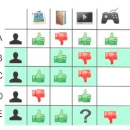Collaborative filtering (CF) is a long-standing problem of recommender systems. Many novel methods have been proposed, ranging from classical matrix factorization to recent graph convolutional network-based approaches. After recent fierce debates, researchers started to focus on linear graph convolutional networks (GCNs) with a layer combination, which show state-of-the-art accuracy in many datasets. In this work, we extend them based on neural ordinary differential equations (NODEs), because the linear GCN concept can be interpreted as a differential equation, and present the method of Learnable-Time ODE-based Collaborative Filtering (LT-OCF). The main novelty in our method is that after redesigning linear GCNs on top of the NODE regime, i) we learn the optimal architecture rather than relying on manually designed ones, ii) we learn smooth ODE solutions that are considered suitable for CF, and iii) we test with various ODE solvers that internally build a diverse set of neural network connections. We also present a novel training method specialized to our method. In our experiments with three benchmark datasets, Gowalla, Yelp2018, and Amazon-Book, our method consistently shows better accuracy than existing methods, e.g., a recall of 0.0411 by LightGCN vs. 0.0442 by LT-OCF and an NDCG of 0.0315 by LightGCN vs. 0.0341 by LT-OCF in Amazon-Book. One more important discovery in our experiments that is worth mentioning is that our best accuracy was achieved by dense connections rather than linear connections.
翻译:合作过滤系统( CF) 是长期存在的建议系统问题。 许多新颖的方法已经提出, 从古典矩阵要素化到最近的图形进化网络化方法。 在最近激烈的辩论之后, 研究人员开始关注线性图形进化网络( GCNs), 并使用层组合, 显示许多数据集中最先进的精确度。 在这项工作中, 我们根据神经普通差异方程式( NADEs) 扩展这些网络。 因为线性GCN 概念可以被解释为一个差异方程式, 并且提出了基于学习- 时间的 ODE 合作过滤( LT-OCF) 的方法。 我们的方法中的主要新颖之处是, 在重新设计 NODE 系统顶端的线性G 组合( GCNs) 之后, 我们学会了最佳的架构, 而不是人工设计的组合组合。 我们学习了被认为适合 CFC 的平滑滑的 ODE 解决方案, 并且我们用各种ODE 解算器来建立一套不同的神经网络连接 。 我们还用一种全新的培训方法来专门进行 0CN 0.04 -04 。 在我们三个基准级的 GN- G- G- Gl- LE 中, 的精确的连接中, 而不是以一个更精确的方法, GOW 以不断的精确的方法来显示一种更精确的方法。




